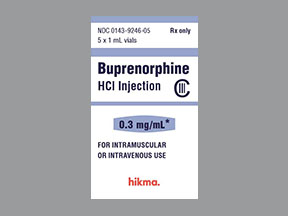
Buprenex Coupons & Savings Card – Discount Prices from $7.60
Brand for: Buprenorphine
My prescription
Edit
1ML of 0.3MG/ML, Buprenorphine (1 Syringe)
Select pharmacy

CVS
$35.32
COUPON PRICE
Walgreens
$7.60
COUPON PRICE
Albertsons
$16.42
COUPON PRICE
Walmart
$16.61
COUPON PRICEBuprenex savings card
Show this card to your pharmacist
Walgreens
$7.60
BIN
ID
PCN
GRP
011867
LHA44BD911
HT
LABH001
Powered by
Related opioid agonist/antagonists prescriptions
More prescriptions for pain
Related opioid agonist/antagonists prescriptions
More prescriptions for pain
Buprenex (Buprenorphine) dosage forms
Dosage Quantity Price from Per unit 1ML of 0.3MG/ML 1 Vial $21.68 $21.68 1ML of 0.3MG/ML 2 Vials $34.36 $17.18 1ML of 0.3MG/ML 3 Vials $47.04 $15.68
| Dosage | Quantity | Price from | Per unit |
|---|---|---|---|
| 1ML of 0.3MG/ML | 1 Vial | $21.68 | $21.68 |
| 1ML of 0.3MG/ML | 2 Vials | $34.36 | $17.18 |
| 1ML of 0.3MG/ML | 3 Vials | $47.04 | $15.68 |
Buprenex Warnings
Buprenorphine is a medication that comes with certain risks and safety concerns. It is crucial to understand these risks to ensure safe use. Below are important safety details and warnings associated with buprenorphine.
Risk of Addiction and Abuse: Buprenorphine is a controlled substance that can lead to addiction, abuse, and misuse. This increases the likelihood of severe side effects, including potentially fatal breathing issues. It is important to use the lowest effective dose for the shortest duration to manage pain. Patients with a history of substance or alcohol abuse should discuss their concerns with their healthcare provider.
Breathing Problems: The medication can cause dangerously slow breathing, especially when treatment begins or if the dose changes. The risk is higher if you are taking other substances that can depress breathing, such as alcohol, benzodiazepines, or sedatives, or if you have respiratory conditions like COPD or asthma. Immediate medical attention is necessary if breathing difficulties or bluish discoloration of lips or nails occur.
Pregnancy and Newborn Risks: Using buprenorphine during pregnancy can lead to withdrawal symptoms in the newborn, which can be life-threatening. Pregnant women should only use this medication when clearly needed and under medical supervision. Symptoms in newborns may include persistent crying, poor feeding, and seizures. Inform your provider if you are pregnant or plan to become pregnant.
Adrenal and Blood Pressure Concerns: Long-term use of opioids can lower adrenal hormone levels. Though rare with buprenorphine, symptoms like nausea and dizziness should be reported. Additionally, the medication can cause blood pressure to drop suddenly, particularly when standing up. Patients should rise slowly and report any symptoms of dizziness or fainting.
Heart Rhythm and Allergic Reactions: Buprenorphine can cause QT prolongation, a serious heart rhythm condition. Those with existing heart problems or taking QT-prolonging medications should inform their provider. Also, watch for signs of severe allergic reactions, such as swelling or difficulty breathing, and seek immediate help if they occur.
Gastrointestinal and Seizure Risks: Avoid buprenorphine if you have known blockages in the stomach or intestines. It may also trigger seizures in those with a seizure history, so inform your provider if this applies.
In case of an overdose, emergency treatment with naloxone may be necessary. It is wise to have naloxone available and educate family members about its use. Always consult your healthcare provider about potential interactions with other medications or substances.
Buprenex Side Effects
When taking this medication, you may experience nausea, vomiting, constipation, lightheadedness, dizziness, drowsiness, headache, or sweating. These common side effects might lessen as your body adjusts to the treatment. Some individuals might also notice redness, itching, or irritation at the injection site. If any of these symptoms persist or worsen, it's important to consult your healthcare provider promptly. To alleviate constipation, it is advisable to consume dietary fiber, stay well-hydrated, and maintain a regular exercise routine. A pharmacist can recommend a suitable laxative if necessary. To minimize dizziness and lightheadedness, rise slowly from sitting or lying positions. While serious side effects are uncommon, be vigilant for symptoms like interrupted breathing during sleep (sleep apnea), mental or mood changes (such as agitation, confusion, hallucinations), difficulty urinating, or signs of adrenal insufficiency like loss of appetite, unusual tiredness, and weight loss, and report these to your doctor immediately. Seek urgent medical help for very serious side effects such as fainting, seizures, slow or shallow breathing, severe drowsiness, difficulty waking, fast or irregular heartbeat, or severe dizziness. Buprenorphine can, in rare cases, cause serious liver issues. Look out for persistent nausea or vomiting, loss of appetite, stomach pain, jaundice, or dark urine, and get medical assistance promptly if these occur. Although a severe allergic reaction is rare, seek immediate help if you notice a rash, itching or swelling (especially of the face, tongue, or throat), severe dizziness, or difficulty breathing. This summary does not include all possible side effects. If you observe any unusual symptoms, contact your healthcare provider for advice.
Buprenex Interactions
What is the drug Buprenex used for?
Buprenex is used for the management of moderate to severe pain. It is an opioid analgesic that works by binding to specific receptors in the brain to help alleviate pain.
Is Buprenex the same as Suboxone?
Buprenex and Suboxone are not the same, although they both contain buprenorphine. Buprenex is a formulation of buprenorphine used primarily for pain management, while Suboxone contains buprenorphine and naloxone and is used for opioid dependence treatment.
What are the side effects of Buprenex?
Buprenex, which contains buprenorphine, can cause several side effects. Common side effects include nausea, vomiting, dizziness, headache, drowsiness, and constipation. Some individuals may experience sweating, dry mouth, or blurred vision. Serious side effects, though less common, can include respiratory depression, severe allergic reactions, and changes in mood or behavior. It is important for individuals to contact their healthcare provider if they experience any severe or concerning symptoms.
What is the generic name for Buprenex?
The generic name for Buprenex is buprenorphine.
What does Buprenex do to humans?
Buprenex, which contains buprenorphine, is used in humans primarily for the management of moderate to severe pain. It works by binding to opioid receptors in the brain, altering the perception and response to pain. It can also produce effects such as sedation and euphoria.
